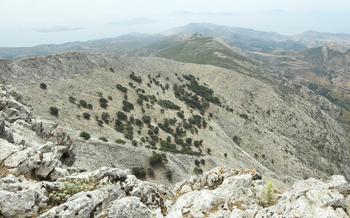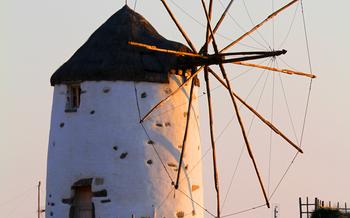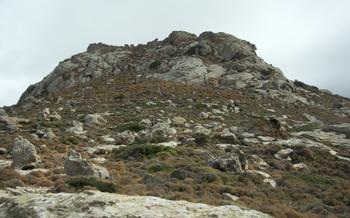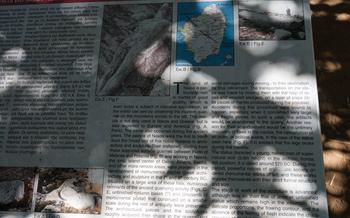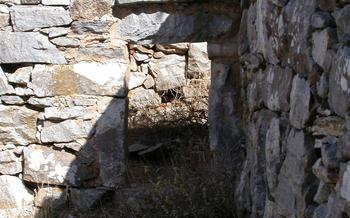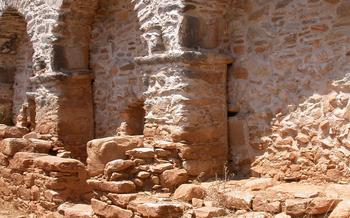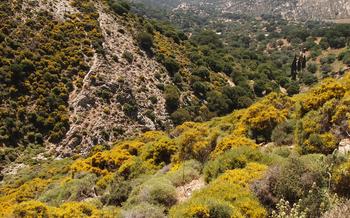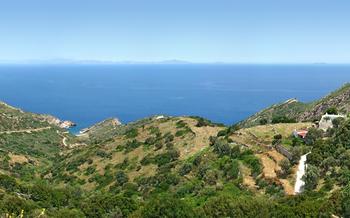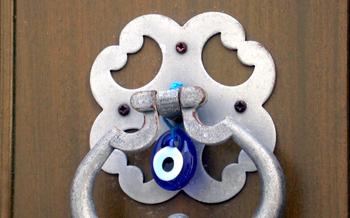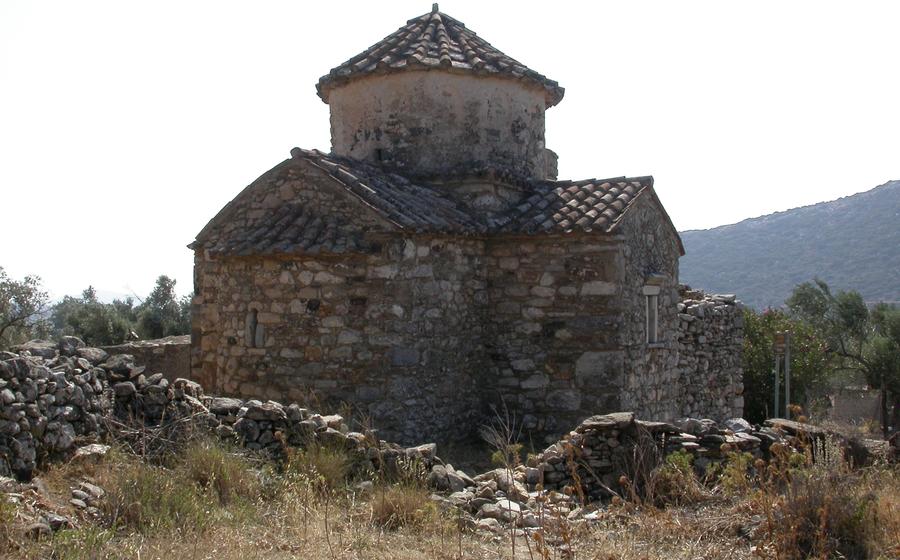
Tripodes Windmills
- Historical Background
- Location and Getting There
- Exploring the Windmills
- Visiting the Museum
- Panoramic Views
- Windmill Activities:
- Gastronomic Delights
- Local Products and Souvenirs
- Beaches Nearby:
- Photography Opportunities
- Avoiding Crowds
- Respecting the Environment
- Insider Tip: Unveiling the Cave of Zas
Historical Background
The iconic windmills of Naxos are a testament to the island's rich history and cultural heritage. Their origins can be traced back to the Venetian rule in the 16th and 17th centuries when the island was a major producer of wheat and other grains. The Venetians, known for their maritime prowess and engineering skills, introduced the technology of windmills to the island.
The windmills were strategically placed on the hilltop of Chora, the main town of Naxos, to capture the strong winds that sweep across the island. Constructed using local materials such as stone and wood, the windmills exhibited a unique architectural style that blended Venetian and Cycladic influences. Their conical towers, topped with thatched roofs, gave them a distinctive appearance that set them apart from other windmills in Greece.
These windmills played a crucial role in the local economy. They were used to grind wheat into flour, providing a vital food source for the island's population. The flour was then used to produce bread, pasta, and other staples. The operation of the windmills was a labor-intensive process, with the millers working long hours to meet the demand for flour.
Location and Getting There
Situated on the rugged west coast of Naxos, the Tripodes windmills stand tall on a hill overlooking the picturesque fishing village of Chora. This captivating location can be easily accessed from Naxos Town, the island's main port. Regular public buses and taxis are readily available, offering a scenic journey along the winding coastal roads.
For those seeking a more leisurely and immersive travel experience, renting a car or motorbike is an excellent option. The drive along the coast boasts breathtaking views of the sparkling Aegean Sea and the rugged landscapes of Naxos. Once you reach Chora, signs will guide you to the Tripodes hill, where the windmills proudly stand.
If you're an enthusiastic cyclist or prefer to embrace the natural beauty of the island, cycling to the windmills is an exhilarating experience. The route offers panoramic vistas and a chance to discover hidden coves and charming villages along the way. However, it's essential to be prepared for some challenging climbs, as the terrain can be hilly.
Once you arrive at the windmills, ample parking space is available, ensuring a hassle-free visit. The site is wheelchair accessible, allowing everyone to enjoy the wonders of these iconic structures.
Exploring the Windmills
The Tripodes Windmills are striking structures, each standing tall with a conical tower made of stone and whitewashed walls. Their sails, once used to capture the wind, have been preserved, providing a glimpse into the past. Visitors can wander among the windmills, admiring their unique features and learning about their operation. The windmills consist of three main parts: the tower, the cap, and the sails. The tower houses the grinding mechanism, while the cap rotates to face the wind, ensuring optimal wind capture. The sails, made of canvas or wood, harness the wind's energy to turn the millstones, which grind the grain into flour. Notice the intricate details of the windmills, such as the wooden beams supporting the sails and the metal gears that connect the cap to the grinding mechanism. These elements showcase the ingenuity and craftsmanship of the mill builders.
Visiting the Museum
Amidst the majestic windmills of Naxos, a treasure trove of knowledge and history awaits discovery at the dedicated Windmill Museum. Delve into the rich heritage of these iconic structures through captivating exhibits and interactive displays that bring their stories to life. Learn about the ingenious engineering, the role of the windmills in shaping the local economy, and the lives of the millers who once operated them.
Engage in hands-on experiences that allow you to grind flour using traditional techniques, simulating the process that was once essential to the island's livelihood. Immerse yourself in the sights, sounds, and scents of a bygone era as you explore the museum's collection of artifacts, photographs, and multimedia presentations.
Guided tours are available for those seeking a deeper understanding of the windmills' significance. Knowledgeable guides will lead you through the exhibits, sharing insights and anecdotes that paint a vivid picture of their past. Plan your visit during the museum's opening hours, typically from 9 am to 5 pm, and take advantage of the affordable admission fees.
Panoramic Views
Prepare to be mesmerized by the unparalleled vistas that unfold from the windmills, inviting you on a visual journey like no other. Overlooking the picturesque village of Chora, the windmills offer a bird's-eye perspective of the charming town, its whitewashed houses cascading down the hillside, and the sparkling Aegean Sea stretching out beyond. Gaze upon the neighboring islands of Paros and Iraklia, their silhouettes adorning the horizon, and let the panoramic beauty transport you to a realm of tranquility and awe.
Capture the essence of Naxos in a single frame as you witness the harmonious blend of nature's elements. The windmills stand as silent sentinels, their silhouettes etched against the backdrop of the azure sky, while the gentle breeze whispers secrets of the island's rich past. As the sun dips below the horizon, the sky transforms into a canvas of vibrant hues, casting a warm glow upon the windmills and painting a picture that will forever be etched in your memory.
Windmill Activities:
The Tripodes Windmills offer a range of activities and workshops that provide visitors with hands-on experiences and a deeper understanding of these historic structures. One popular activity is a guided tour, led by knowledgeable experts who share insights into the history, operation, and cultural significance of the windmills. Visitors can also participate in a flour-grinding workshop, where they learn the traditional techniques of milling and get to grind their own flour using the windmills.
Throughout the year, the windmills host various events and festivals that celebrate the local culture and heritage. These events often feature traditional music, dance performances, food stalls, and demonstrations of windmill operation. One of the most popular events is the annual Windmill Festival, which takes place in August and showcases the rich history and traditions of the island. Visitors can enjoy live music, traditional Greek dancing, and a variety of local delicacies while exploring the windmills and learning about their significance.
Gastronomic Delights
After exploring the windmills, indulge in the culinary delights that Naxos has to offer. Traditional Greek tavernas and charming cafes dot the area, inviting you to savor authentic flavors with a view. Order a refreshing glass of ouzo, a local anise-flavored spirit, to whet your appetite. For a taste of Naxian cuisine, sample the mizithra cheese, a soft, white cheese made from sheep's milk, often served with honey and sesame seeds. Don't miss the patatato, a Naxian potato dish cooked with meat and spices, or the sfougato, a savory pie filled with cheese, meat, and vegetables.
For a memorable dining experience, reserve a table at a taverna overlooking the windmills. As the sun sets, the sky transforms into a canvas of vibrant colors, casting a magical glow on the ancient structures. Enjoy a leisurely meal while basking in the beauty of the surroundings. Whether you prefer traditional dishes or modern culinary creations, Naxos offers a gastronomic adventure that will delight your taste buds.
Local Products and Souvenirs
In the vicinity of the Tripodes Windmills, visitors will find a treasure trove of local products and souvenirs that celebrate the rich cultural heritage of Naxos. From traditional Greek pottery and handwoven textiles to intricate jewelry and artisanal soaps, there's something for every taste and budget.
One of the most popular souvenirs is the iconic Naxian pottery, known for its vibrant colors and intricate designs. Visitors can choose from a variety of items, including plates, bowls, cups, and vases, each uniquely crafted by local artisans. Another must-have is the handwoven textiles, which showcase the island's rich weaving traditions. From colorful rugs and blankets to delicate lace and embroidery, these textiles make for beautiful home décor or personal accessories.
For those looking for something more unique, the Tripodes Windmills area is home to several jewelry shops that specialize in handmade pieces inspired by the windmills and the surrounding landscape. From delicate silver necklaces featuring windmill motifs to striking earrings adorned with colorful gemstones, these one-of-a-kind creations are sure to turn heads.
Visitors can also find a variety of artisanal soaps and body products made with local ingredients, such as olive oil, honey, and lavender. These natural products are not only gentle on the skin but also evoke the scents and flavors of the island.
When shopping for souvenirs, it's essential to remember the significance and symbolism behind each item. The windmills, for example, are a symbol of Naxos's rich history and resilience, while the pottery and textiles reflect the island's traditional craftsmanship. By purchasing local products, visitors not only support the local economy but also take home a piece of Naxos's unique identity.
Beaches Nearby:
The Tripodes windmills are conveniently located near several pristine beaches, inviting visitors to combine their cultural exploration with a refreshing seaside experience. Within walking distance lies Agios Prokopios Beach, a stunning stretch of golden sand and crystal-clear waters. This picturesque beach offers a range of amenities, including sun loungers, umbrellas, and water sports facilities.
For those seeking a more secluded retreat, Mikro Vigli Beach is a hidden gem just a short drive from the windmills. This intimate cove boasts crystal-clear waters ideal for swimming, snorkeling, and diving. Visitors can relax on the pebbled shore, surrounded by breathtaking views of the Aegean Sea and the neighboring islands.
Plan a delightful day trip by packing a picnic lunch and enjoying a leisurely meal amidst the natural beauty of these nearby beaches. While basking in the sun and cooling off in the refreshing waters, you'll have the unique opportunity to gaze upon the iconic windmills, adding a touch of history and charm to your beach escape.
Photography Opportunities
The windmills of Naxos provide a picturesque backdrop for photography enthusiasts of all levels. With their iconic silhouettes against the backdrop of the Aegean Sea, these windmills offer a myriad of opportunities to capture stunning images.
For those seeking the perfect postcard shot, the best vantage point is from the beach below the windmills. From here, you can capture the full grandeur of these majestic structures, with the blue waters of the Aegean Sea providing a vibrant contrast.
To add depth and interest to your shots, try experimenting with different angles and perspectives. Climb up the hill behind the windmills for a bird's-eye view, or venture closer to capture intricate details and textures. The play of light and shadow throughout the day creates ever-changing compositions, so be sure to visit at different times to capture the windmills in various moods.
For those interested in capturing the essence of the windmills' operation, visit during the windy season (June-September) when the sails are in full motion. The rhythmic swishing of the sails against the backdrop of the blue sky creates a mesmerizing spectacle that is sure to captivate your lens.
Whether you're a seasoned photographer or simply enjoy capturing memories, the windmills of Naxos offer a wealth of opportunities to create stunning images that will transport you back to this magical place.
Avoiding Crowds
The Tripodes Windmills are a popular tourist destination, and as such, they can get quite crowded, especially during the peak season. If you want to avoid the crowds, there are a few things you can do.
-
Visit during the shoulder season. The shoulder season in Naxos runs from April to May and from September to October. During these months, the weather is still pleasant, but there are fewer tourists.
-
Visit on a weekday. Weekends are typically busier than weekdays, so if you can, try to visit the windmills on a weekday.
-
Visit early in the morning or late in the afternoon. The windmills are open from sunrise to sunset, so you can beat the crowds by visiting early in the morning or late in the afternoon.
-
Explore the surrounding area. There are plenty of other things to see and do in the area surrounding the windmills. Take some time to explore the nearby beaches, villages, and hiking trails.
By following these tips, you can avoid the crowds and enjoy a more peaceful and relaxed visit to the Tripodes Windmills.
Respecting the Environment
The Tripodes Windmills are a testament to the ingenuity and craftsmanship of the Naxian people. As visitors, it's our responsibility to preserve these iconic structures and their surroundings for generations to come.
Here are some guidelines for responsible tourism:
-
Tread Lightly: Stick to designated paths to avoid damaging the delicate ecosystem.
-
Leave No Trace: Pack out all your trash, and never leave anything behind except footprints.
-
Respect the Locals: Be mindful of noise levels and respect local customs and traditions.
-
Support Sustainable Initiatives: Choose accommodations and restaurants that prioritize sustainability.
By following these guidelines, we can help ensure that the Tripodes Windmills remain a source of pride and joy for the Naxian people and visitors alike.
Remember, responsible tourism is not just about protecting the environment, but also about respecting the local culture and traditions. Embrace the opportunity to learn from and engage with the Naxian people, and leave a positive impact on the island.
Insider Tip: Unveiling the Cave of Zas
Venture off the beaten path and discover the hidden gem known as the Cave of Zas, nestled near the Tripodes Windmills. This captivating natural wonder is a testament to the rich geological history of Naxos. Explore its enchanting chambers and marvel at the mesmerizing stalactites and stalagmites that adorn the cave walls. As you delve deeper into the cave, you'll be rewarded with breathtaking views of the windmills from a unique perspective.
For an unforgettable experience, plan your visit during the evening when the setting sun casts a golden glow upon the cave's interior, creating an ethereal ambiance. Capture stunning photographs that will transport you back to this magical place long after your visit. Remember to bring a flashlight or headlamp to illuminate your journey through the cave's hidden depths.
Insider's Tip: To fully appreciate the beauty of the Cave of Zas, consider visiting during the off-season when there are fewer tourists, allowing you to soak in the tranquility of this natural wonder.
